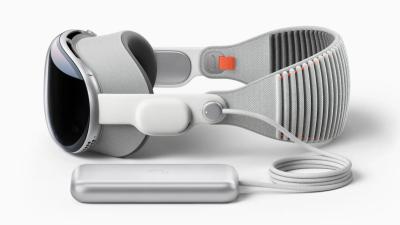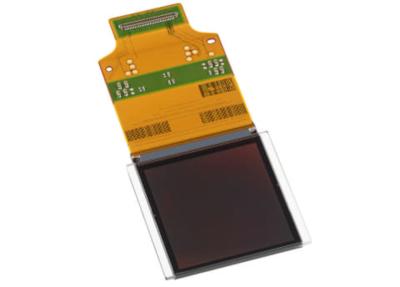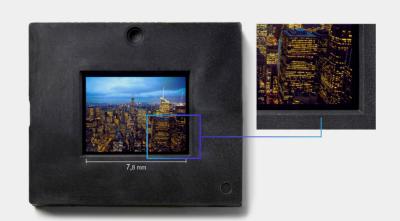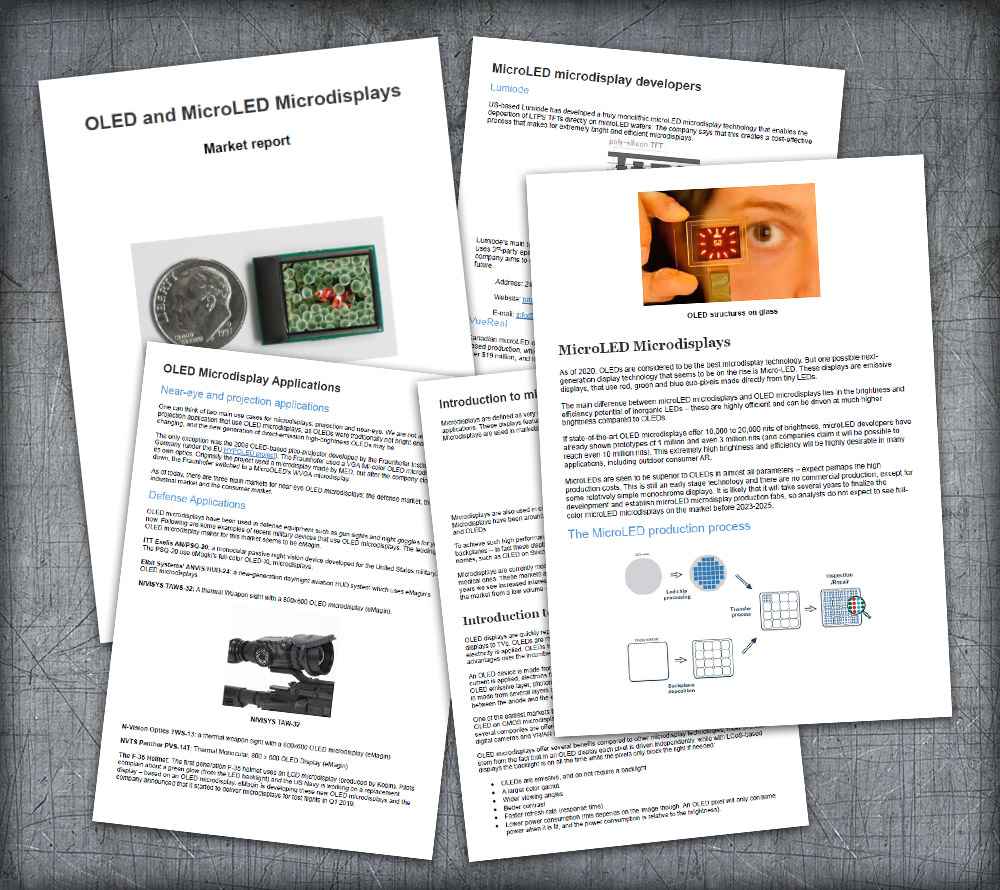OLED is a next-generation display technology that is replacing LCD displays in several markets, such as small displays for mobile applications, TVs and microdisplays. OLEDs are made from thin films of organic light emitting materials that emit light when electricity is applied. OLEDs have a much simpler structure compared to LCDs and have several advantages over the incumbent technology.
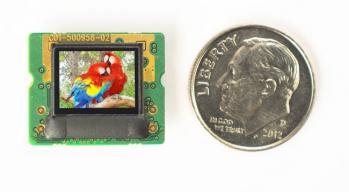 eMagin XGA096 OLED-XL
eMagin XGA096 OLED-XL
OLED microdisplays
OLED microdisplays are considered to be the current state-of-the-art near-eye display technology. OLEDs offer many advantages over competing technologies:
- No backlight - a direct emissive display with high contrast and a wide color gamut
- Fast refresh rate
- Low power consumption (this depends on the image shown)
- Wide operation temperature range
OLEDs do suffer from lower lifetime, limited market capacity, high price. Many believe that microLEDs will offer the ultimate solution for microdisplays, with their inherent high brightness and efficiency, but these displays are not commercial yet.
The OLED Microdisplay market
Several companies in the US, Europe and Asia are producing OLED microdisplays - including eMagin, Sony, OLiGHTEK, Kopin, BOE and SeeYa.
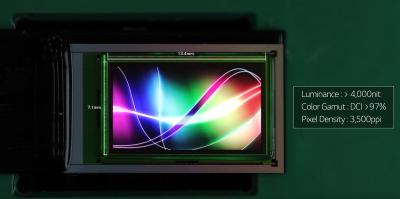
If you're interested in adopting OLED microdisplays in your device, we'll be happy to help, you can browse available display in our OLED marketplace. Be sure to send us a mail and together we can find the best display for your project.
OLED-Info's OLED and MicroLED Microdisplay Market Report
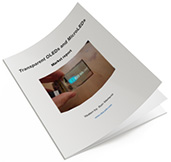 If you want more in-depth information on the OLED (and MicroLED) Microdisplay market, look no further! Our OLED and MicroLED Microdisplay Market Report explains:
If you want more in-depth information on the OLED (and MicroLED) Microdisplay market, look no further! Our OLED and MicroLED Microdisplay Market Report explains:
- Why OLED microdisplays are better than LCD or DLP ones
- The disadvantages of OLED microdisplays
- What kind of displays are available on the market today
- New technologies on the horizon, including MicroLED microdisplays
The report package also provides a complete list of OLED and microLED microdisplay makers and developers, their current (and future) products, and personal contact details into the leading microdisplay makers. Read more here!
The latest OLED microdisplays news:
Samsung to reportedly launch a high-end VR HMD powered by dual OLED microdisplays
According to reports, Samsung Electronics is working on a new VR headset that it plans to release in the second half of 2024.
The new headset will be based on OLED microdisplays, apparently produced by Samsung Display. The reports suggest the the microdisplays will be similar to the 1.41" 4K Sony OLED microdisplays used by Apple in its Vision Pro headset.
Russian citizens arrested in the US, claimed to have illegally bought OLED microdisplays for Russian customers
The New York State Attorney has arrested a Russian citizen called Maxim Marchenko, and two other co-conspirators, accusing them of buying $1.6 million worth of military-grade OLED microdisplays and smuggling these to Russia. The US export control laws forbid the sale of such components to Russian companies.
According to the prosecutors Marchenko hid the fact that these displays were going to Russia, and claimed that these will be used by Chinese companies for use in electron microscope for medical research. Marchenko was charged with seven criminal counts including wire fraud, smuggling, money laundering and four conspiracy counts.
Reports suggest LG Display decided to postpone its OLED microdisplay fab
LG Display has been developing OLED microdisplay technologies for several years (branding these as OLEDoS), and last year it was reported that LGD is planning to build its first production line, as hoping to supply OLED Microdisplay to Apple in the future. LG is reportedly started ordering deposition equipment from Korea-based OLED equipment maker Sunic System.
According to the Korean publication The Elec, LGD has decided not to build an OLED microdisplay production line, at least for now. The company will continue its R&D project, though.
The US Navy placed a $347 million order to replace the F-35 helmets, to adopt OLED microdisplays in the new design
According to reports, the U.S. Navy’s Naval Air Systems Command has placed a $347 million order with Lockheed Martin for a specialized helmet for pilots of the F-35 fighter jet. The new helmet, developed in collaboration between Collins Aerospace and Elbit Systems, will feature an OLED microdisplay, to replace the currently-used LCDs.

In 2018, we reported that the current F-35 Joint Strike Fighter helmet uses an LCD microdisplay (produced by Kopin), which suffers from a green glow (from the LED backlighting) that prevents pilots from seeing a carrier's lights at night. In addition, the current LCD display suffers from optical blooming - light that spills from lit pixels to their adjacent area. Following these issues, the US Navy started testing OLED microdisplays to replace the LCD.
Apple aims to adopt lower-cost OLED microdisplays at future Vision Pro products, in talks with BOE and Seeya
Apple first VR headset, the Apple Vision Pro, adopts dual 1.3" 4K OLED microdisplays made by Sony. According to reports, Apple is looking to replace Sony as its supplier and is testing displays made by Seeya and BOE. Apple seems to be aiming to adopt these in its next-gen Vision Pro model - and also in a future low-cost mixed-reality headset.
Sony officially launched its 1.3" 4K OLED displays last week, with an official price of $1,000 per unit. Some reports suggest that Apple is paying $350 per display - which is still very expensive, as the two OLED displays cost almost half of the total production cost of the Vision Pro (estimated at $1,500).
Sony officially launches its 1.3 4K OLED microdisplay product
Back in 2021, Sony unveiled a 4K OLED microdisplay prototype. In June Apple announced the Vision Pro headset, which uses two Sony-made 1.3" 4K (3,552 × 3,840) OLED microdisplay, made by Sony. And today Sony finally officially introduced its ECX344A display, targeting VR and AR devices.
Sony says that in order to develop the new display it developed new miniaturization processes as well as a new pixel drive circuits and a high-speed driver circuit. Sony says that the display will ship by the end of 2023 and its price is set at 150,000 Yen, or just over $1,000 USD (it is estimated that Apple pays around $350 for each panel).
OLED microdisplay developer MicroOLED raised 21 million Euro to accelerate its R&D and expand its production capacity
French OLED microdisplay maker MicroOLED announced that it has raised €21 million, led by Jolt Capital and with support from the French sovereign wealth fund Bpifrance via its Innovation Defense vehicle, alongside both historical investors, Cipio Partners and Ventech.
MicroOLED updates that it has been granted over 170 patents to date, through a close collaboration with neighbor CEA/Leti research centers. The company offers a line-up of compact products ranging from 0.2" to 0.6" in size, with high resolution and power as low as 1mW. MicroOLED will use to funds to accelerate its R&D, expand its production capabilities in Grenoble and grow its international sales teams.
Apple said to reduce its planned Vision Pro production volume as Sony cannot ship enough OLED microdisplays in 2024
Apple recently announced the Apple Vision Pro VR headset, with dual 4K OLED microdisplays produced by Sony. Sony's production capacity was known to be limited, and it was estimated that its entire capacity is around 900,000 units per year.
A new report by the Financial Times now suggests that Apple originally planned to produce around a million Vision Pro units in 2024, but it has scaled down its plan and now aims to produce only 150,000 units. The reports suggest that critical components are to blame, but it remains to be seen whether Apple will actually be able to sell a large number of these highly expensive devices.
Seeya orders OLED microdisplay deposition equipment from Sunic Systems in a $25.5 million deal
OLED microdisplay developer Seeya Information Technology has ordered OLED deposition (evaporation) equipment from Korea's Sunic System, in a deal worth $25.15 million.
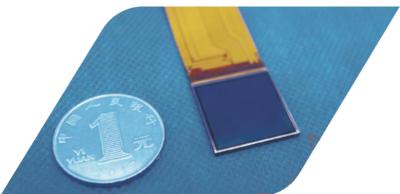
Sunic Systems will provide Seeya with 12-inch (300 mm) OLED deposition tools. Sunic is developing direct-patterning deposition equipment, but it is not clear whether this order is for such tools or whether these will be the standard white OLED with color filter deposition.
A new version of our OLED and MicroLED Microdisplay Market report released
Today we published a new edition of our OLED and MicroLED Microdisplays Market Report, with all the latest information. The new edition offers more that a dozen new updates, new companies, new brochures and catalogs, and more. Global multinational companies are working hard to develop and deploy next-generation AR and VR devices, and these devices will all be based on OLED and microLED microdisplay engines.
Reading this report, you'll learn all about:
- The advantages of OLED and MicroLED microdisplays
- The microdisplays that are available on the market today
- Information on all companies involved in this market
- Future technologies and roadmaps
The report package also provides:
- A list of all OLED microdisplays on the market
- A list of all OLED and MicroLED microdisplays makers
- Microdisplays spreadsheet
- Over 25 datasheets, presentations
- Free updates for a year
This microdisplays market report provides a great introduction to OLED and MicroLED microdisplays, and covers everything you need to know about the current status of the market and industry. This is a great guide if you're considering to adopt OLED microdisplays in your product, if you're looking to learn more about next-generation micro-LEDs and if you want to understand this industry better.
Pagination
- Previous page
- Page 3
- Next page


